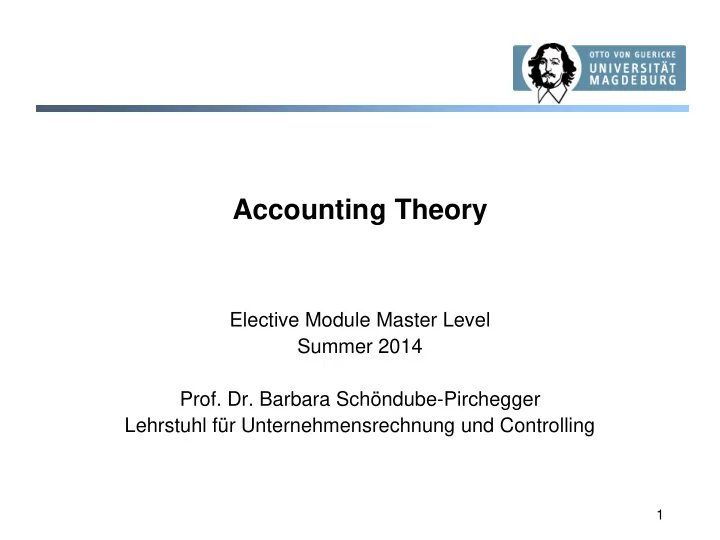

Accounting Theory Elective Module Master Level Summer 2014 Prof. Dr. Barbara Schöndube-Pirchegger Lehrstuhl für Unternehmensrechnung und Controlling 1
Administrative Information • Class Schedule – Lecture Hours: Wednesday 9:15-10:45 – Tutorial: Tuesday 13:15-14:45, first lecture April 8. – Grading: 60 min exam • Lecturer contact – Office: Vilfredo Pareto Gebäude (G 22), Room E 209 – Office Hours: Thursday 11-12 a.m. or by appointment – E-mail: barbara.schoendube@ww.uni-magdeburg.de – Phone: 67 18728 • Website: http://www.bwl1.ovgu.de/ – Particular link to class website: http://www.bwl1.ovgu.de/bwl1/en/Teaching/Accounting+Theory-p-358.html 2
Textbook • Demski, Joel S., Managerial Uses of Accounting Information , Second Edition, Springer (2008) – Available online via SpringerLink http://link.springer.com • Focus: managerial uses of accounting information – We stress the construction as well as the use of accounting information, rather than how to produce it • How can accounting information be used? – Our approach is conceptual and abstract – The course focuses on fundamentals – Basic knowledge about financial accounting and economics is required 3
Introduction • Accounting is the language of business – Transactions are reflected in monetary terms – Accounting information conveys information about the firm to internal and external parties: • Internal: managers, employees • External: investors, potential investors, competitors, tax authorities • The accounting system can be regarded as a library – It stores financial data of a firm – It is organized in some fashion – The manager uses the library to gather information – The manager’s choices are reflected in the library 4
Frame of the analysis • Uncertainty is present • Accounting is one of many information sources available to the management of a firm – Accounting information combines with non-accounting information in counter-intuitive ways • Multiple products or services • Decision makers are economic agents who maximize (expected) utility • Accounting is costly 5
1. The economist’s view: a single product firm • Trade takes place in a perfect market: – The product with all its characteristics is known • Every quantity q can be traded – Price is known – No transaction costs • The firm straddles (input and output) markets • Factor inputs, e.g. capital and labor, z 1 , z 2 are used to produce output q 6
Production Plan • The firm straddles two input markets and one output market, all perfect with prices • It maximizes profit subject to its technology s.t. • Example 2.1 : Suppose for and • Feasible possibilities to produce : and => • Example 2.2 : Given , , => s.t. • Optimal solution: • Note: no reference to cost or revenue here 7
The economic cost function • The cost function displays the cost of producing different output levels given that input factors are optimally used s.t. • Solving this problem results in and • Resulting in: 8
9 The economic cost function
Cost function terminology • Definition 1 : In the single product firm, average cost at output quantity is total cost divided by quantity, or . • Definition 2 : In the single product firm, the incremental cost of units at output quantity is the difference between the cost of producing units and units, or . • Definition 3 : In the single product firm, the marginal cost of output at output quantity , denoted , is the rate at which cost changes with respect to change in quantity, or . 10
11 Average and marginal cost
Adding an upper bound on factor z 1 s.t. • Note: the final line denotes the shadow price of an additional unit of z 1 • In the same sense MC denotes the shadow price of an additional unit of q 12
Cost and revenue framing • Having constructed the cost function allows us to rephrase the firm’s previous maximization problem using revenues and costs • This implies the well known optimality condition: „marginal revenue = marginal cost“ 13
Short run versus long run cost • Long run costs: all factors can be varied – • Short run: only some of the input factors can be varied – • Short run cost curve: s.t. • Definition 4 : In the single (or multi-) product firm, fixed cost is the short-run cost of zero output, or for some defined short-run setting. • Definition 5 : In the single (or multi-) product firm, variable cost of output is the short-run cost of producing output less the corresponding fixed cost, or for some defined short-run setting. 14
15 Short run and long run cost curves
Recommend
More recommend